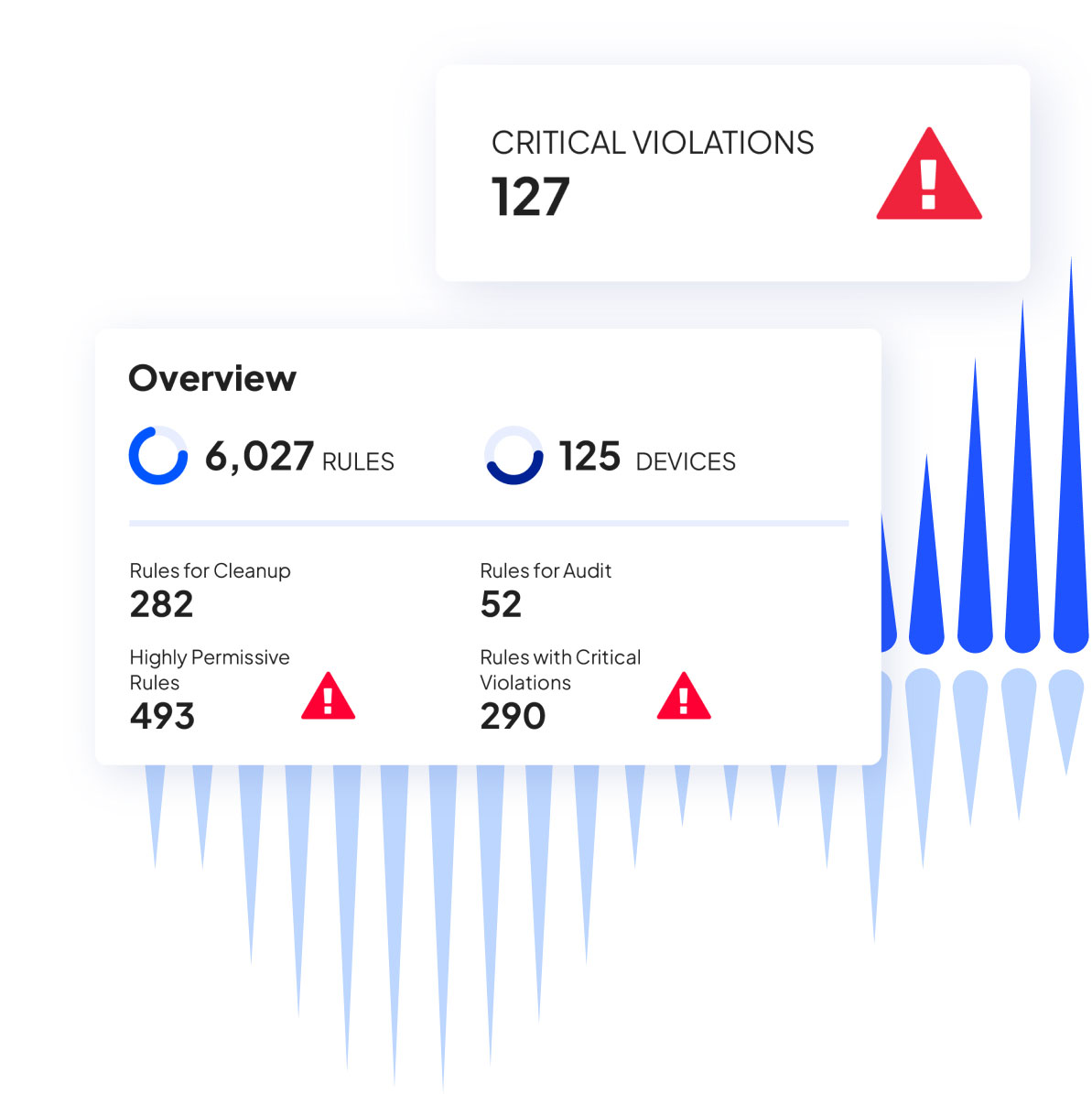
How does Tufin measure up vs. Firemon?
“We identified [other solutions], but we found that they were not as mature as Tufin, not offering the same range of Firewall Vendors, e.g. Palo Alto, Check Point, etc., and the same level of automation.”
Find out why thousands of customers trust Tufin





Better Visibility with the Best Dynamic Topology Modeling
Tufin provides the most accurate topology and path analysis, powering enterprise-wide network awareness across on-premises networks and hybrid cloud environments. Tufin’s unmatched visibility is why so many organizations rely on us to improve their cybersecurity posture via real-time risk alerting, automated target selection and network security control optimization recommendations. Firemon lacks the topology modeling functionality necessary to power comprehensive security policy automation from ground to cloud.
Features Comparison
Accurate topology modeling for VMware NSX-T and Cisco ACI
Complete Cisco SD-WAN network model
Accurate topology modeling for public cloud environments, including AWS, Azure and Google Cloud Platform
OOTB topology support for NAT, VPN, MPLS, BGP and more
Network topology expansion via the UI with generic capabilities, such as interface, route, VPN, L2 FW and more
Network connectivity troubleshooting via an interactive topology map using NGFW features, such as UserID, AppID, and more
Ability to generate security policy based on existing connectivity
Risk analysis against internal policies and industry regulations with OOTB regulation templates
Risk analysis takes into account vulnerability scans and other third-party security intel to operationalize cybersecurity fundamentals that are difficult to master via manual processes
Continuous monitoring for violations and real-time alerting
Centralized, holistic security policy management and change tracking
Superior Automation from Network Change Request to Provisioning
Tufin delivers superior firewall management and cloud connectivity management, and it easily integrates with ITSMs and any other 3rd-party system to automate and orchestrate network access configuration changes, rule cleanup, server decommissioning, and more. Every action is logged for comprehensive, automated change management. Firemon cannot match Tufin’s automation functionality.
Features Comparison
Fully customizable, end-to-end network access change workflow with the ability to easily add/remove steps to align with the organizational process
Possible to establish zero-touch automation from request to provisioning
Construct a global security policy based on App IDs
Change automation support for VMware NSX-T and Cisco ACI
Design, provisioning, and ongoing management of network security device rules
Policy design based on existing network traffic and least-privilege principles
Manage the entire rule lifecycle with rule recertification and cleanup workflows
Risk analysis incorporating security intelligence, internal policies and regulations
NGFW support (e.g. Palo Alto Networks Panorama and Fortinet Fortigate integration)
Automate policy changes for user access based on LDAP groups
Vulnerability mitigation and vulnerability-based change automation
Access decommissioning
Auto zone updating via IPAM integration
Rule and group modification
Server policy cloning
Server decommissioning
Tufin provided us with an overall state of our firewalls that enables us to operate in a much more agile, proactive and strategic manner.
Performance at Scale with Unmatched Extensibility
No cracking under complexity. Tufin’s security policy management solution supports 1000s of firewalls, network devices, and public cloud resources — and up to 100 million routes.
Features Comparison
A single topology view for thousands of devices; no grouping requirements or small number limits
Automatic population of zones from IPAM solution
Can manage thousands of devices and cloud resources and 100M+ routes with little or no performance degradation
Tufin enables API integration with the more solutions than Firemon, AlgoSec or Skybox across the network operations, network security, cloud security and incident response ecosystems
Code free integration – easy, GUI-driven integration with third-party products
OOTB integrations with vulnerability scanners, IPAM, ITSM, SIEM, SOAR, and more
Manage the entire rule lifecycle with rule recertification and cleanup workflows
Enrich SOAR playbook and SIEM analysis with network intelligence
FAQs
According to Gartner, “Network security policy management tools can help security and risk management leaders meet multiple use cases by offering centralized visibility and control of security policies across hybrid networks, risk analysis, real-time compliance, and application mapping.”
NSPMs provide a central management layer across multi-vendor on-premises networks and hybrid cloud environments from which to design network security policies and segmentation strategies, deploy those security policies across devices, monitor for violations, and track policy changes.
Tufin is the leading NSPM due to its dynamic network and cloud topology modeling, advanced automation workflows, scalability and extensibility.
Firewalls are security checkpoints that allow the approved computer systems to send communications via a secure network or interact with another system, and they block unwanted systems or communications (network packets) from gaining access.
It’s a simple enough concept, and yet firewall security policies — their rule sets — can be very complex. Firewall rule sets can grow to thousands of rules, intended to govern which connections and content may be allowed through. Adding to that complexity is that fact that most enterprise networks consist of dozens or hundreds of multi-vendor firewalls, each with their own management tools. Large enterprises can have thousands of firewalls.
There are several different types of firewall:
Packet filtering firewalls inspect the IP header of packets, allowing access or blocking packets, based source and destination IP addresses, protocols and ports.
Circuit-level gateways are rarely used as a standalone solution. They work at the session layer, relaying or blocking network communications based on transmission Control Protocol (TCP) or User Datagram Protocol (UDP) handshakes. They relay these packets from a proxy server that is being used as an added layer of protection to the internal server.
Stateful inspection firewalls work at layers 3 and 4, inspecting packets and monitoring the state of active network connections. They build profiles for each active connection using IP addresses, packet inspection and other context. When a subsequent connection is attempted, it is checked against the profile attributes, and if found to be safe, the traffic is allowed.
Application-level gateways (proxy firewalls) can detect and block threats that aren’t detectable at the network or transport layers. They hide the details of the private network, protect user anonymity and offer more granular security controls. Packet filtering is based on the service for which the packets are intended and other attributes, such as the HTTP request string. They inspect all communications, including the IP address, port, TCP header, and the content itself.
Next-generation firewalls (NGFWs) track all traffic from layer 2 to 4. They are application-aware and connection context-aware, combining packet filtering, stateful inspection, malware filtering, and other network security tool enrichment to deliver advanced protection. They require integration with an organization’s other network security solutions, in order to maximize value.
Tufin’s network topology map provides visibility and context others can’t match, supporting customers with thousands of devices and global hybrid networks. This topology-driven approach enables more effective risk management, policy clean-up, and segmentation design.
Tufin Orchestration Suite provides the business application context for managing network connectivity and security. By linking applications directly to security policy, Tufin eliminates the complexity of traditional firewall rule changes. This approach also supports compliance management, reduces human error, and accelerates secure cloud migration.
Tufin is the most extensible solution in the NSPM market, supporting virtually any vendor, including Cisco, Palo Alto Networks, Check Point, Juniper, Fortinet, Google Cloud, Microsoft Azure, and many more. This breadth surpasses AlgoSec’s vendor coverage.
